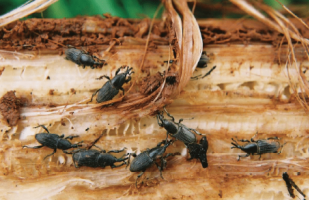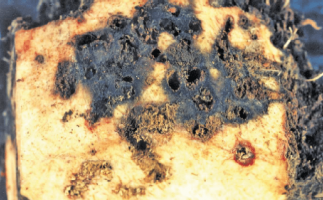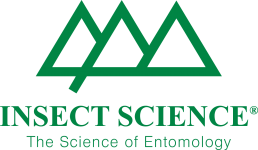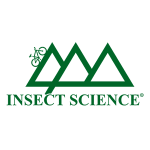Host plants
The banana weevil only attacks plants of the genera Musa and Ensete, family Musaceae. No banana cultivar is totally resistant to C. sordidus, but tolerance amongst some wild genotypes have been observed.
Damage
Damage is caused by the larvae, which tunnel in the corm and pseudostem and between the lateral roots and rhizome (illustrated). Symptoms of infestations include stunted growth and yellow plants, withered leaves in young plants and the production of smaller bunches with yield losses of up to 50%. Severe infestations may lead to plants being easily blown over whereas infected plants are also prone to secondary fungal infections. All these symptoms are more prominent in drought stressed plantations. The banana weevil is by far the most destructive banana pest and is largely responsible for the rapid decline in banana plantations in tropical and subtropical countries all over the world. It had already become a serious pest in the major banana producing areas of Africa by the early 1940’s. Since the 1970’s, this insect slowly spread through all the banana producing regions of South Africa and is now rated by some growers as being a bigger threat to banana production in South Africa than the Panama disease.
Life history
The female excavates a cavity in the base of a pseudostem with her rostrum, into which she deposits a single egg. The egg cavity is sealed because the tissue bordering the egg dies and shrinks after a few days. Egg laying continues throughout the winter, but prominent peaks occur during spring and autumn.
The incubation period varies considerably depending on the temperature. During cold spells, periods as long as 30 days have been recorded, while periods as short as four days have been recorded during summer. The mean incubation period is 8 days. No eggs are deposited on dead plant material.
After hatching, the larva tunnels into the rhizome where it feeds. Larval tunnels have a maximum diameter of about 6 mm. The development rate of the larvae varies between 25-100 days, with an average of 40 days. At the end of this stage, the larva constructs a pupal cell close to the outer surface of the plant. The ensuing pre-pupal phase lasts approximately four days and the pupal stage about eight days.
Weevils stay in the pupal cells for approximately 7-14 days while undergoing sclerotization and melanization. The average life cycle from egg to adult takes about 47 days to complete. Adult weevils are nocturnal and although they have relatively well-developed wings, flight has only been observed on rare occasions. They generally spread very slowly and movement of weevil infested plant material is usually responsible for the introduction of the weevil into previously uninfected areas.
Natural enemies
No information is available on the natural enemies of this weevil in South Africa. Several predators have been recorded from elsewhere, including predatory beetles of the families Histeridae, Hydrophilidae and Staphylinidae, which have been used in the biological control of the banana weevil. Other known natural enemies include entomopathogenic nematodes and microbes.
Management
The use of cultural practices has been shown to be the most important aspect of control for small scale banana farmers. In this regard residual pseudostems should be cut as close to the soil surface as possible and then cut into smaller blocks, which will dry out quickly, thereby reducing the availability of oviposition sites for the weevil.
In cases where plantations are replanted with suckers, all possible precautions should be taken to ensure that the plant material is clean, as the transportation of infested sucker material is the weevil’s main mode of dispersal.
Several dual purpose chemicals aimed at killing both the banana weevil and the plant nematodes are known to provide effective control. Timing of insecticide applications is important. Weevils tend to move about considerably just after or during rainy periods. Optimal application time will therefore be immediately after rain since the weevils will then have the best opportunity to come into contact with insecticides.
Trapping and the manual destruction of weevils is a major component of weevil control in some developing countries. The pseudostem of a recently harvested plant should be chopped into blocks (300 x 600 mm) placed with the cut end facing towards the soil. To minimize dehydration and enhance effectiveness, these traps should be covered with dead plant material and left for about seven days. Adult beetles will congregate under these traps (illustrated) and can easily be collected by hand. The use of pheromone baited traps is less labour intensive but results under South African conditions have so far not been promising.







